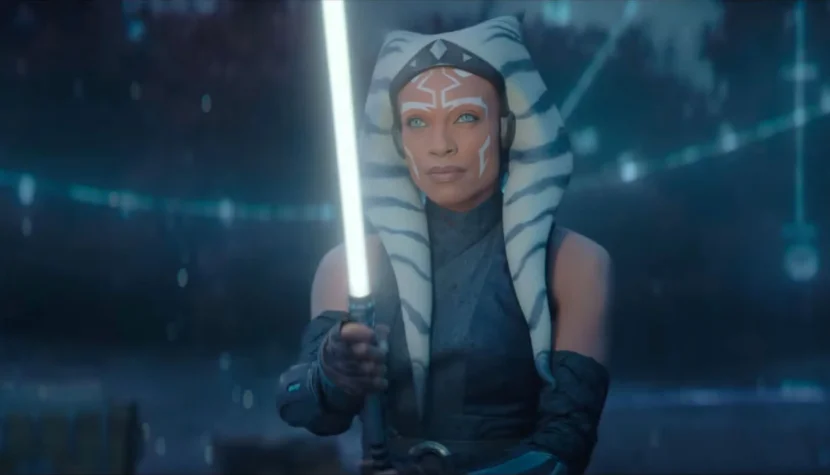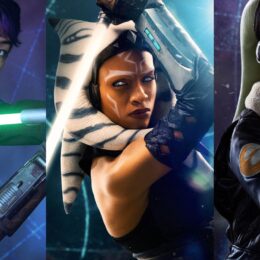AHSOKA: Feminist “Star Wars”? [Review of the First Two Episodes]

Right after the world finally saw the trailer for Rebel Moon, a film entirely conceived by Zack Snyder, inspired by Star Wars, Disney reminds us of its presence by placing a product bearing its trademark into the hands of fans. The Star Wars saga returns in another serial installment. Once again, we are presented with a story centered around a specific character in the universe. In fact, a female character and heroines, as the first thing that catches the eye after watching the first two episodes of Ahsoka is the fact that it is a series with a strong female presence. Is it already feminist? It’s too early to discuss that.
However, it seems to me that the driving force behind this concept had to be “the boss” of Star Wars, the progressive Kathleen Kennedy, who has often emphasized in interviews that the stories from the distant galaxy created under her guidance are intentionally imbued with social aspects. I don’t see this as a criticism, as long as the creators have a plan for skillfully presenting socially sensitive themes within the framework of science fiction or, more precisely, space fantasy. Science fiction has always served this purpose, let’s state it openly. There is one condition, though – there needs to be a creative idea behind it; the characters cannot sound or look like cardboard placards, whether advocating for women’s rights or sexual minorities. More story, less policy – one might say.

However, Ahsoka is not just the first Star Wars universe series entirely based on a female character, but it also features crucial female characters in supporting roles. This perspective seems peculiar from my point of view. For now, I give it the green light, as I have a feeling that the creators have a plan for this gathering of witches. Why do I think so? Ahsoka is Dave Filoni’s brainchild, the director who introduced this character to the Star Wars universe in the animated series The Clone Wars, as well as in later Rebels. Filoni, more than anyone else, knows the motivations of his “mascot,” the distinctive Jedi warrior, and he also knows who should partner with her to captivate the audience with her story. I trust him. It’s worth realizing that until now, before the premiere of this series, as Star Wars fans, we hadn’t previously had the chance to see a female take on the master-apprentice relationship. This element, which is, after all, the core of this story, had thus far been reserved exclusively for men.
Beyond its irresistible feminine aura, Ahsoka also possesses other quite intriguing aspects. The story is set to focus on the search for the elusive archenemy, Thrawn. A highly electrifying and enigmatic character. Thrawn appeared in Rebels, and since then, speculation about whether we will see this antagonist in live-action Star Wars productions has not ceased. As it seems, these prayers have been answered, so Thrawn is undoubtedly an aspect of Ahsoka that will maintain our interest for a long time. Let’s hope the creators don’t prolong the chase for this carrot indefinitely, as fans probably won’t forgive that. Rumor has it that Anakin, a.k.a. Darth Vader, will also make an appearance – whether this will come to fruition, I don’t know, but this character has already been suggested in one of the episodes.
I appreciate the way Sith and the Empire are portrayed in the series, particularly in terms of the characters. In Obi-Wan, we got to know an incredibly charismatic warrior with a red lightsaber up close. In Andor, we were introduced to former Imperial officials, which I found extremely interesting because it added a human aspect where it had been absent before. Ahsoka continues down this path, shedding light on areas that were typically shrouded in darkness and fear in the movies. We meet Baylan Skolla and his apprentice, providing a counterbalance to the Ahsoka and Sabine Wren duo. Already, it’s evident that Baylan is an enigma; his motivations are difficult to decipher, and as a result, it’s clear that he’s not entirely good, but it’s challenging to determine whether he’s as rotten to the core as Palpatine would wish. Note – this character is also significant for another reason. Unfortunately, it’s one of the posthumous farewells to Ray Stevenson, who passed away quite suddenly not long ago. It’s a pity, really.
As of now, the plot unfolds at a leisurely pace. Similar to The Mandalorian, the action takes place after the events of Return of the Jedi. It’s worth noting that Filoni somewhat celebrates individual shots featuring Ahsoka Tano, such as her looking around a room or searching for an object. This speaks volumes. Ahsoka is a series whose creators were well aware that it would generate interest from the start due to the promise of developing the story of a female Jedi character who has been captivating audiences for years. Rosario Dawson seems to be the perfect fit for the role, as confirmed by her earlier appearance in The Mandalorian. In fact, that very appearance somewhat “sealed the deal” for the creation of this series.
Filoni is evidently fulfilling his dream, and I wish him success (he’s officially announced to direct a full-length movie as an extension of his work on this series). It’s clear that he’s not in a rush to unveil the cards before us and dazzle us with something spectacular. He doesn’t want to win our hearts in a flashy or cheap manner. Instead, he projects through Ahsoka that he simply wants to savor the opportunity to create this series. And in turn, infect us with that joy.


